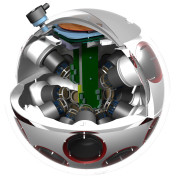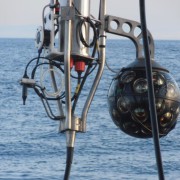Each detector of the KM3NeT neutrino research infrastructure is a three dimensional array of sensor modules distributed over large volumes of the transparent water in the deep Mediterranean sea. The sensor modules are pressure resistant glass spheres housing multiple photomultiplier tubes for light detection and several instruments to determine the geometrical position of the sensor modules and to calibrate the measured signals. The sensor module is also referred to as Digital Optical Module or DOM for short.
The sensor module – DOM for short
The sensor modules – or optical modules – register the time of arrival of the Cherenkov light generated in the sea water by charged particles created in neutrino induced interaction with the water inside or close to the detector; the modules also measure the brightness of the light and the geometrical position of the sensor at the time of arrival of the light. The measurements are transmitted to computers in a shore station via a network of optical fibres. In the shore station, intelligent software filters the data and reconstructs from the measurements the traces of the particles traversing the detector. The results are sent over the public internet to the KM3NeT data centres for further study by the scientists. The sensor modules of KM3NeT are referred to as Digital Optical Modules – or DOMs for short. For the first time in neutrino telescopes, the KM3NeT optical module is a ‘multi-PMT’ module in contrast to the standard ‘single-PMT’ module.
The multi-PMT optical module
A DOM consists of a glass spherical vessel with a wall thickness sufficient to withstand the enormous pressure of up to 350 times normal atmospheric pressure that exists at the bottom of the sea. In this glass vessel 31 photomultiplier tubes have been arranged to look in all directions for the faint light emitted by particles passing by. Together they form a ‘fly’s eye’
The photomultiplier tubes need to be provided with a high voltage of around 1000V. This is provided by a custom made circuit on the back of the photomultiplier tube. This board has been miniaturised in order to fit in the limited space available in the innards of the glass sphere.
A small electrical pulse is created by the photomultiplier tube when a quantum of light hits it. This pulse is then amplified and transformed into a square wave pulse, by the time-over-threshold technique (the amount of light is transformed to an amount of charge which is in turn translated to the length of the square wave pulse), and sent to the central processing logic housed in a Field programmable gate Array (FPGA) where its arrival time and its pulse length is registered and stored for later transfer to shore. The DOM also contains other sensors used for calibration purposes. A compass makes it possible to know in what direction each of the photomultipliers is pointing. Accelerometers allow tilt, pitch and yaw of the module to be determined. A piezo-acoustic sensor allows for the determination of the position of the DOM in 3D using a sonar technique. All these measurements are important as the DOMs move under the influence of sea currents.
Assembling the multi-PMT optical module requires highly-skilled technicians: see this sneek peak into one of the KM3NeT production labs in Amsterdam, The Netherlands.
Or an animated report of a workshop about assembling optical modules in the CAPACITY lab in Caserta, Italy:
Prototyping
A very important milestone of the project is the in situ prototype validation. In May 2013, a prototype sensor module was successfully installed on an ANTARES detector line and the next year, in May 2014, a prototype string comprising three DOMs was successfully deployed and connected to the KM3NeT-It site at 3500 m depth. Both prototypes operated for more than a year thus providing not only a validation of the technologies, but also a check of the detection capability via the comparison of the response of the prototypes to background light from the decay of radioactive potassium-40 (40K) in the sea water and atmospheric muons expected from Monte Carlo simulation with data.
Scientific papers in peer-reviewed journals
The KM3NeT multi-PMT optical module, The KM3NeT Collaboration, S. Aiello et al., 2022 JINST 17 P0703
Deep sea tests of a prototype of the KM3NeT digital optical module, The KM3NeT Collaboration: S. Adrián-Martínez et al., Eur. Phys. J. C (2014) 74: 3056



